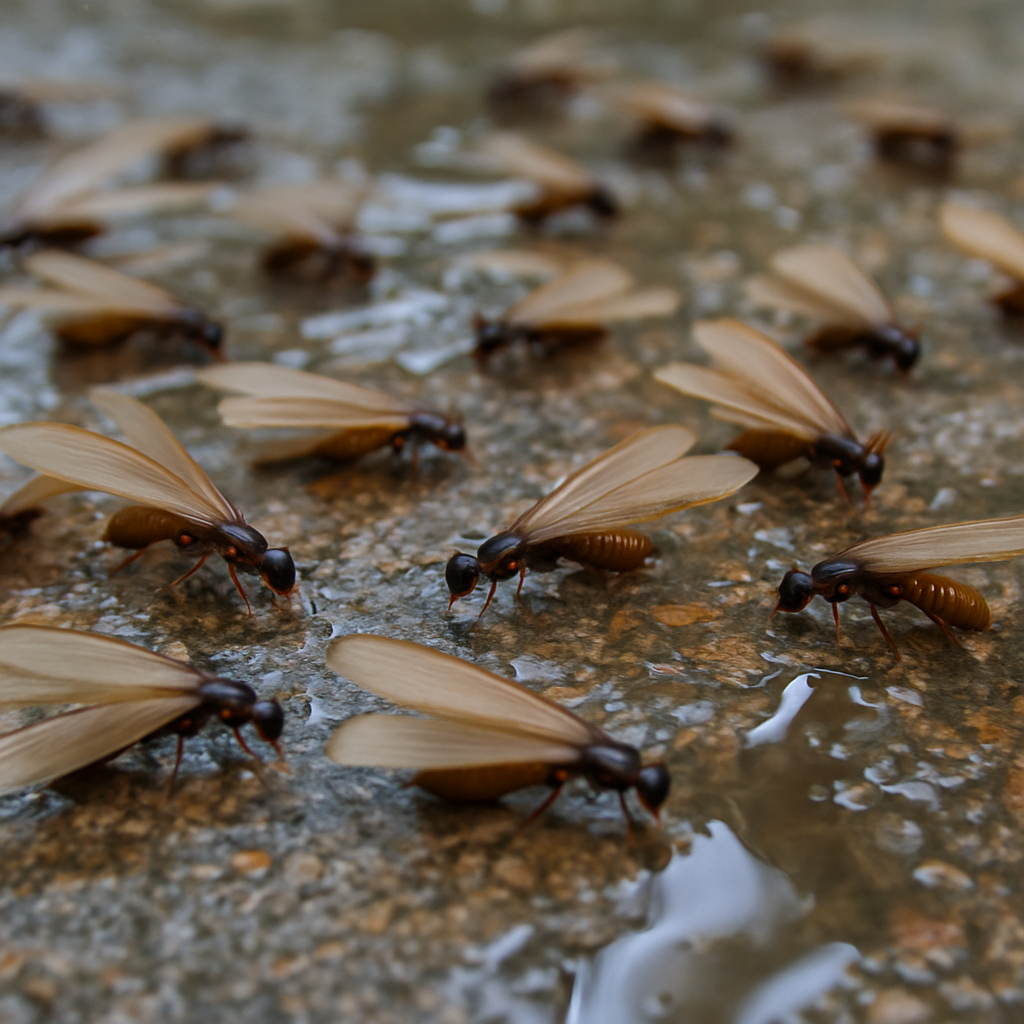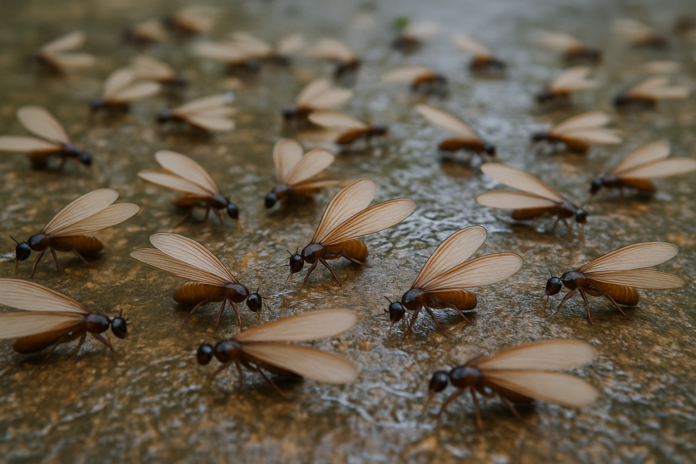Understanding Flying Termites
What Are Flying Termites?
Flying termites, also known as alates, are the reproductive members of a termite colony. Unlike worker termites that remain hidden underground or inside wooden structures, flying termites emerge to mate and start new colonies. These swarmers are often the first visible sign of a hidden termite problem.
Flying termites are easily recognized by their:
- Straight antennae
- Two pairs of equal-length wings
- Thick waists
- Light-brown to dark-colored bodies
Unlike other insects, they are not simply passing through — they could be planning a long-term stay.
Why Do They Fly After Rain?
Flying termites typically swarm after rain because moisture and mild temperatures create the perfect environment for mating. Rain softens the soil, making it easier for female termites to burrow and establish new nests. Moreover, higher humidity levels protect their fragile bodies from dehydration.
The Science Behind Their Swarming Behavior
Termite Life Cycle and Nuptial Flights
The swarm is part of a termite’s natural life cycle. Mature colonies produce winged alates once or twice a year. These alates fly out in large numbers during what is called a nuptial flight. During this event:
- Males and females leave their nest.
- They pair up mid-air.
- Once they land, they shed their wings and start a new colony.
This behavior typically lasts for only a few hours — but the implications for your property could last years.
The Role of Humidity and Temperature

Rain provides a perfect blend of conditions:
- Moist soil for digging nests.
- High humidity that prevents alates from drying out.
- Mild evening temperatures ideal for flight.
Swarming generally occurs late afternoon or early evening when winds are calm and the ground is moist.
Types of Termites That Swarm After Rain
Subterranean Termites
These are the most common and destructive type. They build nests underground and emerge en masse after rain.
Drywood Termites
Less dependent on moisture, but still likely to swarm after rain. They infest dry wooden structures such as furniture and attic beams.
Dampwood Termites
These thrive in decaying wood and are common in moist, forested areas. Rain encourages them to swarm and look for new damp wood to infest.
Common Signs of a Termite Infestation
After a rainstorm, flying termites can indicate an active colony nearby. Look out for:
Visible Swarmers
Dozens of winged termites emerging from walls, floors, or outside near light sources.
Discarded Wings
After landing, swarmers shed their wings. Finding small piles near windowsills, doors, or vents is a red flag.
Mud Tubes and Wood Damage
Termites construct mud tubes to travel safely. Hollow-sounding wood and small holes are clear infestation signs.
Dangers of Flying Termites Near Your Home
Structural Damage Potential
Flying termites are not harmful in themselves — but they can start colonies that eat away at wooden structures. This leads to:
- Weak flooring
- Crumbling support beams
- Wall damage
Risk of Long-Term Infestation
Each flying termite represents a potential new colony. If left unchecked, this can escalate into full-blown infestations costing thousands in repairs.
Preventive Measures to Keep Termites Away
Moisture Control
- Fix leaky pipes and faucets.
- Ensure good drainage around your home’s foundation.
- Use a dehumidifier in basements and crawl spaces.
Sealing Cracks and Entry Points
- Caulk gaps around windows and doors.
- Inspect for cracks in the foundation.
- Install fine mesh screens over vents.
Landscaping and Wood Storage Tips
- Keep mulch and firewood away from the home.
- Trim tree branches near roofs or gutters.
- Ensure your lawn slopes away from the house.
What to Do If You See Flying Termites After Rain
Immediate Steps to Take
- Collect samples or take pictures for identification.
- Inspect common nesting areas like attics and basements.
- Vacuum or sweep visible swarmers and dispose of them.
When to Call a Professional
If you find multiple swarmers or wings, it’s time to contact pest control. A licensed termite inspector can:
- Determine the termite species.
- Evaluate the extent of damage.
- Recommend targeted treatments.
DIY vs Professional Termite Treatment
Pros and Cons of Each Approach
| DIY | Professional |
|---|---|
| Cost-effective | More expensive initially |
| Natural or chemical options | Use of advanced tools |
| May miss hidden colonies | Accurate diagnosis |
| Temporary results | Long-term solutions |
Average Costs and Effectiveness
- DIY Treatments: $50–$300 (for sprays and baits)
- Professional Treatments: $500–$3000 (depending on infestation size)
Natural Remedies and Home Treatments
Orange Oil, Borax, and Diatomaceous Earth
- Orange oil: Destroys termite eggs and exoskeletons.
- Borax: Mix with water to create a termite-killing spray.
- Diatomaceous Earth: Kills termites through dehydration.
Limitations of Natural Methods
While these solutions may work on surface-level problems, they don’t reach deep infestations and often require reapplication.
Termite Prevention Tips for the Rainy Season
Rainwater Drainage Systems
- Ensure gutters and downspouts direct water away.
- Install French drains if needed.
Annual Inspections
Schedule yearly termite checks, especially before and after the rainy season.
Flying Termites vs Flying Ants
Key Differences in Appearance and Behavior
| Feature | Flying Termites | Flying Ants |
|---|---|---|
| Waist | Straight | Pinched |
| Wings | Equal size | Unequal size |
| Antennae | Straight | Bent |
| Behavior | Shed wings | Keep wings |
How to Identify Them Correctly
Use a magnifying glass and flashlight to examine wings and body structure. Misidentification can lead to incorrect treatments.
Termite Swarming Season Explained
When Is the Swarm Most Active?
- Typically late spring through summer.
- Evening hours after rainfall.
How Long Does It Last?
Swarming usually lasts a few hours, but the colony-building that follows can span years if unchecked.
Global Perspectives: Flying Termites in Different Regions
USA
Subterranean termites dominate, especially in the Southeast.
Australia
Flying termites, known as white ants, are common after summer rains.
Africa
Seen as a delicacy in many cultures; commonly collected during rain.
Southeast Asia
Heavy rainfall causes large swarms; often mistaken for seasonal pests.
Cultural Beliefs and Myths About Flying Termites
Superstitions and Symbolism
In some cultures, flying termites symbolize:
- Wealth and prosperity (Africa)
- A bad omen (India)
- Rainy season arrival (Pacific Islands)
Edible Insects in Some Cultures
In parts of Africa and Asia, flying termites are fried or roasted as a protein-rich delicacy.
FAQs About Flying Termites After Rain
1. Are flying termites harmful to humans?
No, but their presence can indicate a nearby colony which may cause property damage.
2. How do I get rid of flying termites naturally?
Use orange oil, vinegar, or borax mixtures. However, call a professional if the problem persists.
3. Why do flying termites come out after rain?
They swarm to mate and start new colonies, taking advantage of moist conditions.
4. Can termites fly into my house from outside?
Yes. Open windows, doors, or vents allow them access during swarms.
5. Are flying ants and termites the same?
No. They differ in body structure, behavior, and damage potential.
6. What’s the best time to treat for termites?
Just before or during the early part of the swarming season is ideal.
Conclusion: Stay One Step Ahead of Flying Termites
Flying termites after rain aren’t just a seasonal inconvenience — they’re nature’s red flag. Their presence signals the possibility of unseen structural damage or an expanding termite colony nearby.
Take preventive steps, identify signs early, and when in doubt, call a professional. Protecting your home starts with knowing what to look for — and acting before it’s too late.


Excellent site. Plenty of useful information here. I am sending it to several pals ans also sharing in delicious. And certainly, thank you in your sweat!